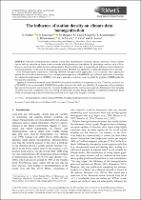The influence of station density on climate data homogenization
Autor(es)
Fecha
2017-11Palabras clave
HOMER - Homogenization - Metadata - Station density - temporal consistency, trend accuracyColecciones
- Artículo científico [171]
Resumen
Relative homogenization methods assume that measurements of nearby stations experience similar climate signals and rely therefore on dense station networks with high-temporal correlations. In developing countries such as Peru, however, networks often suffer from low-station density. The aim of this study is to quantify the influence of network density on homogenization. To this end, the homogenization method HOMER was applied to an artificially thinned Swiss network. Four homogenization experiments, reflecting different homogenization approaches, were examined. Such approaches include diverse levels of interaction of the homogenization operators with HOMER, and different application of metadata. To evaluate the performance of HOMER in the sparse networks, a reference series was built by applying HOMER under the best possible conditions. Applied in completely automatic mode, HOMER decreases the reliability of temperature records. Therefore, automatic use of HOMER is not recommended. If HOMER is applied in interactive mode, the reliability of temperature and precipitation data may be increased in sparse networks. However, breakpoints must be inserted conservatively. Information from metadata should be used only to determine the exact timing of statistically detected breaks. Insertion of additional breakpoints based solely on metadata may lead to harmful corrections due to the high noise in sparse networks.
El ítem tiene asociados los siguientes ficheros de licencia:








